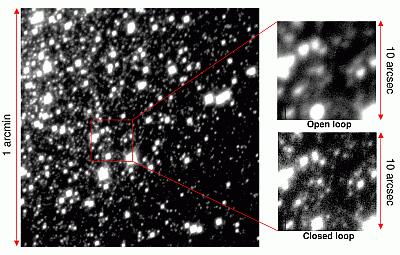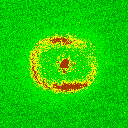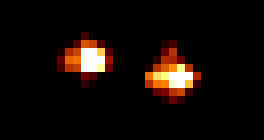
For further images, click here.
NAOMI is mounted at the WHT's GHRIL Nasmyth focus, and delivers near-diffraction-limited images (FWHM ~ 0.15 arcsec, Strehl ~ 0.6 in K) to the IR camera INGRID. NAOMI was commissioned during Aug/Sep 2000 and May/Jun + Sep 2001.
Below is a recent commissioning result: an image of the globular
cluster M13 taken in Halpha light during Sep 2001 tests of
NAOMI's performance in the optical (where AO systems are not expected
to achieve the diffraction limit).
The FWHM has been improved
from 0.7 arcsec (natural seeing) to 0.4 arcsec.
Montage created by Rene Rutten.

For further images, click here.
NAOMI/INGRID is offered in the second half of semester 2002A on a shared-risks basis (other instrumentation may be mounted on the GHRIL Nasmyth platform during the first part of the semester). The observing will be carried out in service mode. NAOMI can be used to image any astronomical target which has a suitable guide star nearby. AO systems at other large telescopes (CFHT, Gemini, Keck I) have been used to study a wide variety of objects, including comets, binary asteroids, cicumstellar disks, dwarf galaxies, AGN, QSO hosts and gravitational lenses.
NAOMI
was built and commissioned by a team from Durham/ATC.
The principal UK contact is
Richard Myers, Durham
ING is happy to help observers with pre-submission technical appraisal
(contact
Chris Benn).
Information about NAOMI and adaptive optics in general is collected below under the following headings:
Information about future AO developments at the WHT (OASIS integral-field spectroscopy, TEIFU, coronograph, laser guide stars), can be found on the AO developments page. There is also a NAOMI technical information page (mainly of interest to the commissioning team).
 90-sec K-band image of planetary nebula BD 303369 (nebula
diameter 3.8 arcsec top to bottom)
90-sec K-band image of planetary nebula BD 303369 (nebula
diameter 3.8 arcsec top to bottom)
 Enlargement of area around central star, FWHM 0.13 arcsec
(look-up table selected to show, very faintly, the first diffraction ring)
Enlargement of area around central star, FWHM 0.13 arcsec
(look-up table selected to show, very faintly, the first diffraction ring)
In natural seeing 0.8 arcsec, with a guide star V = 14 lying close to the (on-axis) target, NAOMI is designed to deliver near-diffraction-limited images in K, FWHM ~ 0.15 arcsec, with Strehl ratio (between the peak heights of corrected and diffraction-limited point-spread functions) ~ 0.4. The predictions below of on-axis Strehl ratio as a function of guide-star apparent magnitude, wavelength and uncorrected seeing are based on models by Ron Humphries and Richard Wilson, Durham, and on preliminary results from commissioning. Planned improvements in operation of the wavefront sensor (probably during 2002A) will eventually allow use of guide stars ~ 1 mag fainter than the limits quoted below.
G-star Band Strehl in seeing FWHM" V mag 1.0" 0.7" 0.5" 11 K 0.46 0.62 0.69 0.12 12 K 0.34 0.51 0.61 13 K 0.19 0.38 0.50 14 K 0.06 0.21 0.35 11 H 0.29 0.45 0.54 0.08 12 H 0.19 0.36 0.46 13 H 0.08 0.24 0.35 14 H 0.02 0.10 0.21 11 J 0.15 0.29 0.38 0.07 12 J 0.08 0.21 0.31 13 J 0.03 0.12 0.22 14 J 0.01 0.04 0.11
(Seeing 1.0, 0.7 and 0.5 arcsec correspond to Fried parameter r0 = 10, 15 and 20 cm respectively.)
For Strehl ratios of more than a few tenths, the bulk of the light will be concentrated in a diffraction-limited core (FWHM ~ 0.15 arcsec in K), with the remainder of the light distributed over the (uncorrected) natural-seeing disk. With poorer AO correction, there will still be a diffraction-limited core, but it will contain only a small fraction of the light. The delivered FWHM is typically close to either the diffraction limit or the tip-tilt-corrected seeing diameter. Strehl is a more useful measurement of performance than FWHM.
Strehl ratio is predicted to fall to half its on-axis value at radii 13, 17 and 23 arcsec from the guide star in J, H and K respectively (the size of the isoplanatic patch scales as wavelength6/5). That is, for a given degree of correction, the guide star needs to be closer to the target for J and H imaging than for K. The sky coverage, i.e. the fraction of sky falling within the anisoplanatic patch of a bright star, depends on required Strehl, and on galactic latitude. In K band, for delivered Strehl 0.3, sky coverage is ~ 10% at galactic latitude 30 deg.
Richard Wilson has provided predictions of the decline in delivered Strehl with separation between target and guide star, for J, H and K bands (the 3 curves are for median and for 25 and 75 percentile seeing conditions, with a bright guide star, V ~ 12).
The Durham team has provided comparable predictions (median, and 25 and 75 percentile), for FWHM in J, H and K bands and for 50%-included-energy diameter in J, H and K bands. The horizontal dotted lines in the figures indicate the median uncorrected values. Median predicted FWHM is < 0.2 arcsec for guide-star radius = 30, 40 and 50 arcsec in J, H and K. At the same radii, the 50% encircled-energy diameters are about 0.4 arscec in each band. I.e. the FWHM can be close to the diffraction limit even when there is < 50% of the total energy in the central peak.
The guide star can be the target itself, if the latter is sufficiently
bright and sufficiently pointlike (< 1.5 arcsec, say, to be smaller
than the sub-aperture guide boxes on the wavefront sensor).
There should be no stars of similar magnitude within ~ 5 arcsec of the
guide star, to avoid confusing the wavefront sensor.
The H-band image below is of a guide star R = 11 which turned out to be
a 0.5-arcsec double. The wavefront sensor guided perfectly well on
this star, delivering FWHM 0.16 arcsec.

The scale at INGRID is 0.04 arcsec/pixel, field of view 40 arcsec (NAOMI's field of view, and the area within which guide stars must fall, is 2.9 arcmin in diameter).
The sky background in J and H is similar to that measured with INGRID mounted at the Cassegrain focus. The K thermal background appeared to be ~ 2 - 3 mags higher than that at Cassegrain, corresponding to ~ 100% emissivity, now traced largely to surfaces in the Nasmyth derotator and in the INGRID foreoptics used with NAOMI. ING plans to recoat/replace these surfaces, but no date can be given.
Throughput to INGRID with NAOMI is about 0.5 times that to INGRID mounted at Cassegrain (due to losses in the GHRIL derotator, and in the NAOMI optics). Signal-to-noise predictions can be made using SIGNAL, the ING signal-to-noise calculator.
Observing overheads with adaptive-optics systems are higher than for normal observing, and these overheads should be included in the request for time. For acquisition of the guide star by the wave-front sensor, observers should allow 5 - 10 minutes per target. For dithered observations, allow ~ 10 sec per dither point (this is for movement of the telescope, corresponding movement of the guide-star pickoff probe, and closure of the AO loop), i.e. ~ 50 sec for a 5-point dither. INGRID itself takes ~ 1.5 sec to read out. E.g. if a coaverage of 40 1-sec exposures is required at a given point (to avoid saturation of the INGRID chip at ~ 25000 counts/pixel), the overhead is ~ 60 sec, i.e. 150%. Additional time should be allowed for calibration of the point-spread function (PSF), if required. The PSF delivered by an AO system is a function of radius from the guide star, but can be estimated by observing star pairs of similar separation (to the guide star and target) at frequent intervals during the night (~ every half hour). For extended targets, offset sky exposures will also be required (as for normal IR observing).
With planned enhancements to the way the wavefront-sensor CCDs are read, the eventual guide-star limit for NAOMI will be ~ 1 mag fainter than quoted in the table above. In the longer term, the use of `zero-noise' CCDs in the wavefront sensor offers another potential gain. Each 1-mag increase in the guide-star limit corresponds to a factor of 3 increase in sky coverage.
The above performance predictions do not take into account wavefront errors induced by the telescope on spatial scales too small (< 50 cm) to be sampled by the spots of the wavefront sensor, although experience with ELECTRA suggests that these are not large.
NAOMI currently feeds only the IR imager INGRID, but its real strength, compared with other AO systems, is expected to be its performance at shorter wavelengths. From late 2002 NAOMI will feed the integral-field optical spectrograph OASIS (formerly at CFHT), and an optical imaging camera is also planned. A coronograph is being designed, and this will feed either the IR or optical imager (~ spring 2002), or OASIS for spectroscopy (~ spring 2003).
NAOMI stands for `Natural-guide-star AO for Multi-purpose Instrumentation'. NAOMI uses a 10*10-element Shack-Hartmann wavefront sensor (built at RAL, based on an 80x80 EEV CCD39) and a 76-element (228 degrees of freedom) segmented deformable mirror. The mirror is the same as that used in ELECTRA, the wavefront sensor is new. The mirror elements are laid out on a 10*10 grid with the corners missing. Most of the deformable mirrors used in astronomical adaptive-optics systems have continuous facesheets. Segmented mirrors allow better correction at short wavelengths, at the cost of higher IR emissivity from the gaps between the segments, and loss of 2% of the incoming light to the same. Positioning of the individual elements of the deformable mirror is unusually accurate, thanks to strain-gauge feedback which ensures a linear response to the requested wavefront corrections. NAOMI is designed to deliver, under median-seeing conditions, Strehl > 0.25 over 50% of the sky, and Strehl > 0.7 over 5% of the sky. At shorter wavelengths, the performance will not be diffraction limited, but there will be partial correction. Click here for an example of correction achieved with NAOMI in R band during the Sep 2001 commissioning (globular cluster M13, 300 sec exposure, airmass 1.4, montage created by Rene Rutten). NAOMI will operate with natural guide stars, but has been designed for simple upgrade to laser-guide-star operation.
NAOMI's predecessor was ELECTRA , which had its final commissioning run at the WHT in May/Jun 1999, using WHIRCAM as a detector. ELECTRA stands for `Enhanced Light Efficiency Cophasing Telescope Resolution Actuator'.
More information about the NAOMI project, including science requirements, and top-level and technical descriptions, can be found on the ATC NAOMI page.
Links to other AO pages around the world:
Adaptive optics techniques improve seeing by ironing out some of the wrinkles imposed on the wavefront as it passes through turbulent layers in the atmosphere. Typically, the wavefront is corrected by making independent tip, tilt and piston movements to each of ~ 10 - 100 elements of a continuous-facesheet mirror in the light path, at ~ 100 - 1000 Hz. The corrections required are obtained by analysing the wavefront (e.g. with a Shack-Hartmann wavefront sensor, curvature sensor or shearing interferometry) from a bright star < 1 arcmin from the object of interest. Most of the distortions imposed by the atmosphere are of phase (typically a few wavelengths across the diameter of a large telescope) rather than of amplitude.
The improvement in image quality is usually characterised by the Strehl ratio = the ratio between the peak intensities of the corrected and unaberrated (diffraction-limited) point-spread functions, maximum value 1.0. FWHM can be a misleading statistic, because partial correction (e.g. tip-tilt only) can yield an image with a narrow core superimposed on a diffuse plateau of emission, the latter including most of the light.
The quality of the seeing is typically parametrised by r0, the
atmospheric coherence length, which is proportional to wavelength^(6/5).
Without adaptive optics, the seeing FWHM is ~ the resolution of a
telescope of diameter = r0, e.g. r0 = 10 cm yields optical
seeing ~ 1 arcsec, r0 = 20 cm yields seeing ~ 0.5 arcsec.
For telescope diameter D < r0, diffraction dominates.
For D ~ r0, image motion dominates (maximum gain is achieved by a tip-tilt
system in this regime.
For D > 4 r0, speckle dominates.
The quality of a site for adaptive optics is determined not only by the
median seeing, but by the height and thickness of the turbulent layers
which cause it (often a few thin layers dominate).
An adptive-optics system can be conjugated to correct for turbulence
originating at a particular height.
Compared with HST, ground-based adaptive optics can deliver better resolution and larger collecting area, but the dynamic range is poorer.
Useful references: